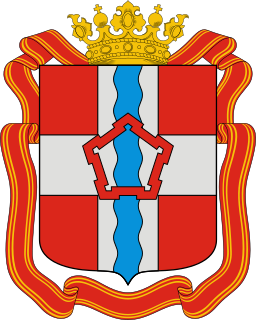
The Great Seal is a principal national symbol of the United States. The phrase is used both for the physical seal itself, which is kept by the United States Secretary of State, and more generally for the design impressed upon it. The obverse of the Great Seal depicts the national coat of arms of the United States.

The coat of arms of the Philippines features the eight-rayed sun of the Philippines with each ray representing the eight provinces which were placed under martial law by Governor-General Ramón Blanco during the Philippine Revolution, and the three five-pointed stars representing the three major island groups of Luzon, the Visayas, and Mindanao.

The national coat of arms of Armenia was adopted on April 19, 1992, by resolution of the Armenian Supreme Council. On June 15, 2006, the Armenian Parliament passed the law on the state coat of arms of Armenia.

The coat of arms of Australia, officially called the Commonwealth Coat of Arms, is the formal symbol of the Commonwealth of Australia. A shield, depicting symbols of Australia's six states, is held up by the native Australian animals, the kangaroo and the emu. The seven-pointed Commonwealth Star surmounting the crest also represents the states and territories, while floral emblems appear below the shield.

The coat of arms of Bulgaria consists of a crowned golden lion rampant over a dark red shield; above the shield is the Bulgarian historical crown. The shield is supported by two crowned golden lions rampant; below the shield there is compartment in the shape of oak twigs and white bands with the national motto "Unity makes strength" inscribed on them.

The coat of arms of Ukraine is a blue shield with a gold trident. Officially referred to as the Princely State Symbol of Volodymyr the Great, or, colloquially, the tryzub, the insignia derives from the seal-trident of Volodymyr, the Grand Prince of Kyiv.

The coat of arms of France depicts a lictor's fasces upon branches of laurel and oak, as well as a ribbon bearing the national motto of Liberté, égalité, fraternité. The arms were created in 1905 by heraldic painter-engraver Maurice de Meyère, and adopted by the French government.

The coat of arms of Romania was adopted in the Romanian Parliament on 10 September 1992 as a representative coat of arms for Romania. It is based on the Lesser Coat of Arms of the Kingdom of Romania, redesigned by Victor Dima. As a central element, it shows a golden aquila holding a cross in its beak, and a mace and a sword in its claws. It also consists of the three colors which represent the colors of the national flag. The coat of arms was augmented on 11 July 2016 to add a representation of the Steel Crown of Romania.

The Great Seal of the State of Hawaii was designated officially by Act 272 of the 1959 Territorial Legislature and is based on the territorial seal. Modifications to the territorial seal included the use of the words "State of Hawaii" at the top and "1959" within the circle. Provisions for a seal for the state of Hawaii were enacted by the Territorial Legislature and approved by Governor William F. Quinn on June 8, 1959. The passage of the Admission Act in 1959, admitted Hawaii as the 50th State of the United States of America on August 21, 1959.

The Coat of Arms of Victoria is the official heraldic symbol of the Australian state of Victoria. Victoria was the second state of Australia to gain arms, granted on 6 June, 1910 by royal warrant of King George V. The state had been named in 1851 after his grandmother, who was in reign at the time. The final version of the arms was granted 28 March, 1978 in the royal warrant issued by Queen Elizabeth II.

The coat of arms of Malta is the national coat of arms of the country of Malta.

The Seal of the State of Texas was adopted through the 1845 Texas Constitution, and was based on the seal of the Republic of Texas, which dates from January 25, 1839.

The coat of arms of Greece comprises a white Greek cross on a blue escutcheon, surrounded by two laurel branches. It has been in use in its current form since 1975. Prior to the adoption of the current coat of arms, Greece used a number of different designs, some of which were not heraldic; the first heraldic design was introduced in 1832 and its main element, the blue shield with the white cross, has been the base for all other national coats of arms since then. The origin of the design is unclear, but it is most likely a heraldic representation of the Greek national flag adopted in 1822, which featured a white cross on a blue field.

The emblem of the Italian Republic was formally adopted by the newly formed Italian Republic on 5 May 1948. Although often referred to as a coat of arms, it is technically an emblem as it was designed not to conform to traditional heraldic rules. The emblem is used extensively by the Italian government.

The Corporate Logo of the City of Sydney was adopted by the City Council on 24 June 1996. It includes a graphic artist's "version" of parts of the actual arms.

The coat of arms of Tunisia displays a Punic galley along with a lion holding a sword, and a weighing scale. In the centre, just under the ship, is the national motto written in Arabic: Freedom (حرية) - Order (نظام) - Justice (عدالة). The central emblem of the national flag is seen above the shield. The background is gold in all sections.

Socialist state emblems usually follow a unique style consisting of communist symbolism. Although commonly referred to as coats of arms, most are not actually traditional heraldic achievements. Many communist governments purposely diverged from heraldic tradition in order to distance themselves from the monarchies that they usually replaced, with coats of arms being seen as symbols of the monarchs.

The Russian heraldry involves the study and use of coats of arms and other heraldic insignia in the country of Russia since its formation in the 16th century. Compare the socialist heraldry of the Soviet period of Russian history (1917–1991).
A national coat of arms is a symbol which denotes an independent state in the form of a heraldic achievement. While a national flag is usually used by the population at large and is flown outside and on ships, a national coat of arms is normally considered a symbol of the government or the head of state personally and tends to be used in print, on heraldic china, and as a wall decoration in official buildings. The royal arms of a monarchy, which may be identical to the national arms, are sometimes described as arms of dominion or arms of sovereignty.

The coat of arms is a symbol of the Omsk Oblast, Russia adopted 29 May 2003. Its authors are Igor Vahitov, Albert Karimov and Oleg Nikitin.


























